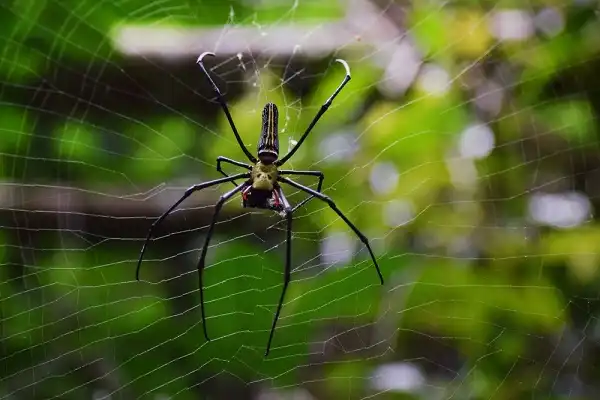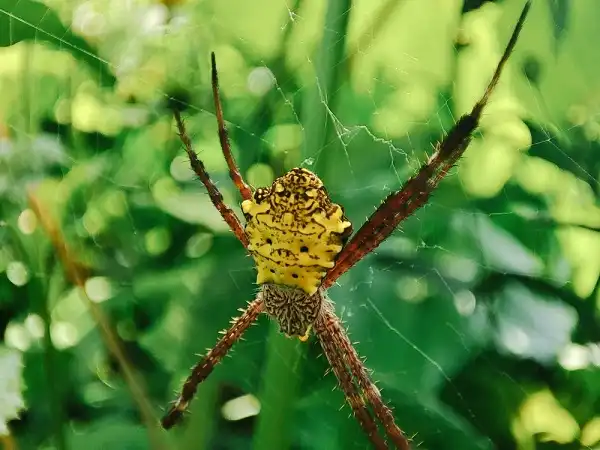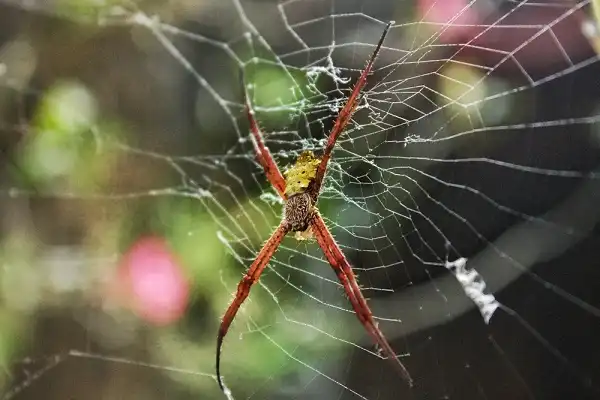Are you afraid of spiders? Does the thought of one lurking in your house make you feel uneasy? If so, then brace yourself for what comes next – because recent studies have uncovered a terrifying new spider that has been dubbed the ‘banana spider.’ This fiercely predatory and surprisingly intelligent arachnid resides in many parts of the world and grows to an impressive size. In this blog post, we’ll be exploring the banana spider‘s bizarre behavior, physical characteristics, habitats, and more – providing you with the information necessary to understand (and relatively co-exist!) these remarkable creatures.

Banana Spider Description
The banana spider, also known as the golden silk orb-weaver spider, is a striking arachnid that boasts an impressive set of physical characteristics. Females of the species are larger and more robust than males. Their bodies are covered in beautiful golden silk that shines brightly in the sun and provides them with the perfect camouflage. The spider’s legs are long and agile, allowing them to move with great speed and precision. They are also equipped with strong hooks and spines that enable them to grip their prey and defend themselves against potential predators. Another striking feature of the banana spider is its unusual coloration. While their bodies are typically bright yellow, they can also appear in shades of green, brown, and even black, depending on their environment.
Banana Spider Habitat
The banana spider is a highly adaptable species that can be found in a wide variety of habitats. They prefer warm and humid environments, such as rainforests and tropical areas, but can also be found in drier regions such as deserts and savannas. These spiders are highly skilled at building their webs in strategic locations to maximize their chances of catching prey. They often create their webs in areas with a lot of sunlight or near water sources, where they are likely to find an abundance of insects. In addition to natural habitats, banana spiders are also known to thrive in man-made environments such as gardens, farms, and even urban areas. They are often found in and around buildings and are known to spin their webs on outdoor lights, window sills, and other structures.
Banana Spider Diet
The banana spider’s predatory nature extends to its diet, as it feeds primarily on insects. Some of its favorite prey include flies, moths, and grasshoppers. However, the banana spider is not limited to these insects and will consume any small creature that crosses its path. One interesting aspect of the banana spider’s diet is its ability to consume prey much larger than itself. This is thanks to its strong, elastic silk that is capable of capturing and subduing insects several times its size. Once captured, the spider will wrap its prey in silk before injecting a potent venom that quickly immobilizes its victim.

Banana Spider Size
The banana spider is an impressive arachnid that is recognized for its intimidating size and unique physical characteristics. These spiders are known for their ability to grow to incredibly large sizes, with some species reaching lengths of up to 10 inches. The females of the species are typically larger than males and can weigh up to 1.5 ounces. One of the standout features of the banana spider is its impressive leg span. These spiders are known for their extremely long legs, which can measure up to 6 inches in length. This, combined with their large bodies, gives these spiders a formidable appearance that can be intimidating to many.
Banana Spider Lifespan
The life span of the banana spider, also known as the golden silk orb-weaver spider, varies depending on its species and gender. Females tend to live longer than males, with some species living up to 2 years. However, most species only live for 1 year. During their lifetime, banana spiders go through several stages of development. They begin as eggs, which are laid in silk sacs and can contain anywhere from a few dozen to several hundred eggs. After hatching, the spiderlings go through several molts before reaching maturity. Once mature, banana spiders typically mate and lay eggs before passing away. While there are some reports of banana spiders living for longer than 2 years, these are considered outliers and not representative of the species as a whole. Interestingly, banana spiders are able to regenerate lost legs or appendages. This means that if they lose a leg in a fight or to a predator, they are able to grow a new one to replace it.
Banana Spider Behavior
One of the most interesting aspects of banana spider behavior is their use of silk webs. These spiders are incredibly skilled at spinning webs that are not only strong but also flexible. They use this silk to create a variety of structures, including shelters and egg sacs. Interestingly, banana spiders also use their webs to communicate with potential mates. Males will pluck the strands of a female’s web to create rhythmic vibrations that signal their presence and interest. Another noteworthy aspect of banana spider behavior is their ability to adapt to their environments. These spiders are found in a range of habitats, from tropical forests to urban areas. They are able to adjust their web-building behavior and hunting strategies based on the resources available to them. For example, in areas with fewer flying insects, they may build webs closer to the ground to catch crawling prey. In terms of social behavior, banana spiders are mostly solitary creatures. However, in some cases, they may form loose colonies with other spiders. This behavior is most commonly observed in areas with abundant food sources, where multiple spiders can coexist without competition.

Banana Spider Speed
When it comes to speed, the banana spider may not be the fastest creature around. These spiders are not known for their quick movements, but rather for their impressive web-building skills and hunting strategies. However, they are able to move relatively quickly when necessary, especially when pursuing prey or avoiding danger. The banana spider’s speed is largely determined by its anatomy. They have long, sturdy legs that allow them to move quickly and efficiently across their webs. Their legs are also covered in tiny hairs that help them grip onto surfaces, even when upside down. In terms of actual speed, banana spiders are able to move at a rate of around 1-3 feet per second. This may not sound like much, but when you consider the terrain they are navigating and the prey they are pursuing, it is quite impressive. Plus, their speed is often not the most important factor in their hunting success – their web-building skills and patience are typically more important.
Banana Spider Hunting
Banana spiders are well-known for their impressive hunting skills. As opportunistic predators, they use their silk-spinning abilities to build webs and catch a variety of insects, including flies, bees, and moths. Unlike some spiders, they do not rely on venom to subdue their prey. Rather, they use their strength and the stickiness of their silk to hold their victims in place. Once the prey is trapped, the banana spider will often bite it and wrap it in additional silk for later consumption. These spiders are patient hunters and will wait for hours or even days for prey to become ensnared in their webs. They are also skilled at detecting vibrations in their webs, which can alert them to the presence of potential food. Banana spiders are able to adapt their hunting strategies based on the resources available to them. In areas with fewer flying insects, they may build webs closer to the ground to catch crawling prey. They are also capable of adjusting the stickiness of their silk to accommodate different types of prey. For example, they may spin silk with a higher stickiness to capture larger insects or a lower stickiness to capture smaller ones.
Banana Spider Venom and Potential Danger
Though banana spiders are not typically a threat to humans, they do possess venom that can be dangerous if ingested. The venom of a banana spider is usually mild and non-toxic to humans, but it can cause skin irritations or allergic reactions in some people. In general, however, their venom poses very little risk to humans and should only be considered if the spider has been handled or bitten. For this reason, it is important for people to take precautions when handling any spider species and to seek medical attention immediately if any signs of an adverse reaction appear. Overall, while banana spiders are not particularly aggressive toward humans, it’s best to observe them from a safe distance whenever possible. And always remember – never touch or handle a wild spider without proper safety precautions.

Conclusion
Banana spiders are an impressive group of arachnids that have adapted to a wide variety of environments. Their anatomy, speed, and hunting strategies make them well-equipped for success in the wild. They possess strong legs covered with tiny hairs that enable them to move quickly across their webs with ease. Additionally, they use their silk-spinning skills to construct intricate webs and patiently wait for prey to become ensnared in them. Finally, they are able to adapt their behavior based on the resources available to them and even engage in cooperative hunting behaviors when necessary. All these attributes combine to make banana spiders successful hunters and important members of the animal kingdom.
Frequently Asked Question

